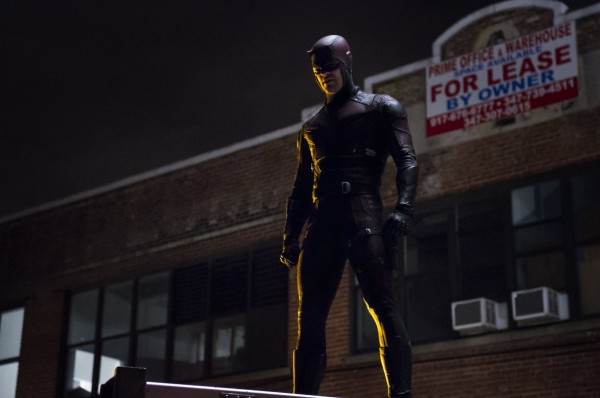Daredevil, Season 1: Episodes 7 to 13
Created by Drew Goddard
Premiered on April 10th, 2015 on Netflix
A paper sign taped up to a tattered door. The white crevices across a painting’s canvass–a reminder of the ebb and flow of wallpaper. A bracelet crafted from an ice cream wrapper. A dead father’s boxing robe. The red horns of the Devil of Hell’s Kitchen. Daredevil‘s imagery has the trappings of iconography. As a comic book adaptation, that’s probably to be expected. But images don’t stick with us as a rule. They have to mean something not just to the fictional characters who experience them, but to us as well. In its first season, Daredevil has found meaning. When Matt uncovers the bracelet he made for Stick in his apartment after the fight with his mentor, his pain is real. Yet, certain things extend to the viewer as well: the idea that we can’t escape who we are, even if we try to convince ourselves that’s what is necessary; the allure of human connection in a lifestyle of self-imposed isolation; the complexities of loving and being loved. For a series to reach these kinds of considerations is to show maturity. To reach them in its first season is to show a kind of potential that is a rare gift.
Generally, that potential is astounding when looking within the frame of the Marvel Cinematic Universe. The praise for Daredevil has been near-unanimous, and to throw my own superlatives at it, this is the best piece in that Universe altogether (Guardians of the Galaxy being a close second and the other MCU films not even holding a candle to the narrative purpose of Daredevil). Specifically, the potential is just as impressive. Where the first half of Daredevil‘s debut season sets up interesting character relations throughout its cast, the second half makes good on that groundwork, challenging most of those characters in physical and emotional ways.
The first two episodes of this second half, “Stick” and “Shadows in the Glass,” are particularly effective at making Daredevil‘s two central characters–Matt and Wilson Fisk–layered and worthy of study. Vincent D’Onofrio’s performance as Fisk immediately joins Tom Hiddleston’s Loki as another of Marvel’s not-so-secret-anymore weapons, and “Shadows in the Glass,” which delves into the character’s backstory, highlights the genuine horror that lies within Fisk’s heart–even more so than when he smashed that dude’s head off with a car door. Written by Steven S. DeKnight, the Fisk-centric episode begins with a stunning sequence of the character preparing for a normal day, set to classical music that eventually transitions into more sinister tones until Fisk sees a younger version of himself covered in blood, the image of which returns later in the episode after we learn how Fisk murdered his own father. Villains are rarely just born, and those that are are often uninteresting in their wholly natural evil. Daredevil recognizes that villains like Fisk are made, and the tremendous work that’s done in “Shadows in the Glass” and the season as a whole shows how to properly calibrate a villain’s arc to make it seem like the hero is up against something almost unstoppable.
“Stick” does similar work for Matt in how it takes the traditional format of the hero’s background but in a way that deepens the experience. The early episodes that focused on Matt’s father would be sufficient enough in explaining why the character does what he does, but “Stick” turns attention towards a different period–the next stage–in young Matt’s life that isn’t bogged down by an unbearable (both for Matt and the viewer) grief. “Stick” gets at the heart of who Matt Murdock is, propelled by a fantastic performance from Scott Glenn, but capped by Matt’s interior conflict. The characters of Daredevil challenge Matt in different ways, especially Foggy in the back half of the season, but Stick’s effect on the would-be superhero is the season’s most poignant.
These, though, are just two highlights in a season that winds up being a collage of smart narrative decisions, impressive physical bouts, daring pushes of boundaries and unique comic book sensibilities for live-action adaptations. The story reaches a crescendo and climax that are telegraphed but made no less effective because of that fact, Daredevil finally taking on the proper mantle and duking it out with Kingpin in a visual spectacle of a boss battle. Major characters’ deaths have legitimate weight and come out of nowhere. And the viewer walks away from the entire experience full and pensive. When Marvel’s films began gaining commercial success and, with the aid of the Dark Knight trilogy, forced cinephiles to look more critically at the sub-genre, these superheroes transitioned from the dark corners of geekdom into wide acceptance, for better or worse. It hasn’t been until this series, however, that the transition has felt as powerful. Daredevil is not just a good series within a popular genre. Daredevil is an openly great series in its own right. Marvel couldn’t have asked for a more surprising and successful addition to its universe from a series that didn’t seem likely to break out after a flop at the cinemas. Netflix couldn’t have asked for a more respectable beginning to its proper foray into superheroes–one that compliments the general high quality of its original programming. And fans and viewers couldn’t have asked for a more addictive and enjoyable jolt of creative energy. Season two can’t come any sooner.
– Sean Colletti



